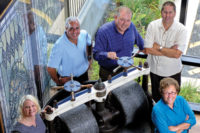Crossing Over
By Jeff Dearduff
Let’s touch on a topic that most of us who make their living on the end of a wrench would avoid as much as a call to the proof box on a hot summer day. We call it “crossing over,” and it refers to the creation of a new batch of bakery mechanics who are coming from that group of employees whom we maintenance folks lovingly call “doughheads.”
You might think this sounds absurd, but taking someone from the production line might be one of the better ways to find your new bakery mechanic trainee.
Think about this for a minute. If operators (or bakers, as they like to be called) have been in the business for any significant length of time, they already are aware of the crazy requirements that are needed to survive in the production environment. They know it’s hot, they know the hours suck, they know the product is very moody, and they know that urgency is critical to keeping the trucks full and the paychecks coming. Couple all that with some basic mechanical aptitude, and you have the makings of a future star in your maintenance department.
One of the quickest ways to improve a bakery’s bottom line is to automate the processes that result in the reduction in headcount in the direct labor column of the ledger.
Automation, however, is sort of a Jekyll and Hyde when it comes to manpower. You eliminate operators on the production line, but you increase the workload on the maintenance staff. Does this mean one for one? Usually not. There will be some tradeoff, but each situation will dictate what the headcount might look like.
For instance, let’s say you have a two-man palletizing operation where cases or baskets come to a location at a certain rate that exceeds their ability to do the job. You install a robotic system that handles the entire process, and you plan to remove those two heads. Then you realize you need someone to load the pallet and slip-sheet magazine, so you really only transfer one head from the job. The simple math says if you are running three shifts, you are dropping three people from payroll. The added equipment creates added workload on maintenance, equaling a quarter of a person per week, so your net is three-quarters of one head per shift. Suddenly you realize that it all contibutes to a significant effect on the bottom line.
Why is this scenario part of the story? Because the automation project described has caused the company to send people heading for the door. In some cases, one of those people can become your next maintenance trainee. Maybe it’s not that specific person, but he or she could transfer to another spot in the process and free up an employee who might be a good candidate to be your next maintenance trainee. Make sense?
So how do we take it from here? At this point, the process varies little from the “bringing the guy in from the outside” training program. However, selecting some from within the operation comes with the bonus that this employee knows the bakery environment.
Have you ever hired a great-sounding maintenance candidate, brought him in, fit him for uniforms, gone through all the paperwork with HR and started spending money on training, only to have your new hire tell you in three weeks that “it’s tooooo hot,” or “weekends don’t work for me?”
We have all been there, and this event probably has tarnished your confidence to bring in future candidates, figuring they will quit, too. This scenario sometimes drives us to the “having a warm body on staff” scenario. These results usually are counterproductive to the developmental goals you have for your department, both short- and long-term, which includes that phone-free vacation you’ve always hoped for.
When you think about bringing people off the production line and putting them into maintenance, your first reaction is going to be a negative one. We are generally a hard-headed bunch who needs to see proof before we buy in to a new way. So here is your proof, at least in words.
I personally have seen “crossing over” work at a bakery that I work with very closely. In this particular case, it involved the maintenance manager who watched and listened over the years as employees worked in the bakery. He made mental notes on those people who seemed to have a mechanical aptitude. When it came time to fill some slots within the shop, he put his plan into action and hired from within. Today, this maintenance shop has 12 hourly mechanics. Four of the current guys came from production, including one who was a bread production foreman.
Nine times out of 10, a person who crosses over from production to maintenance does it because they have ambition and they see a better route to express their talents. Ambition is something that can be hard to find today. Sometimes people don’t know where their talents lie and find themselves stuck in a mud pit.
It’s up to you as managers to keep your eyes open for that one person who needs a rope tossed in and your tug on the other end to bring them to the right side. SF&WB
Editor’s Note: In his monthly column, Jeff Dearduff, director of U.S. bakeries for East Balt, Inc., Chicago, addresses the responsibilities of the bakery engineer. You can contact him at j.dearduff@comcast.net. To read Jeff’s previous columns, visit www.snackandbakery.com




